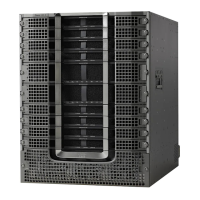the match-any instruction to create a traffic class that uses a class configured with the match-all instruction
as a match criterion (through the match class-map command).
The following example shows how to combine the characteristics of two traffic classes, one with match-any
and one with match-all characteristics, into one traffic class with the match class-map command. The result
requires a packet to match one of the following three match criteria to be considered a member of traffic class
class4: IP protocol and QoS group 4, destination MAC address 00.00.00.00.00.00, or access group 2.
In this example, only the traffic class called class4 is used with the traffic policy called policy1.
Router(config)# class-map match-all class3
Router(config-cmap)# match protocol ip
Router(config-cmap)# match qos-group 4
Router(config-cmap)# exit
Router(config)# class-map match-any class4
Router(config-cmap)# match class-map class3
Router(config-cmap)# match destination-address mac 00.00.00.00.00.00
Router(config-cmap)# match access-group 2
Router(config-cmap)# exit
Router(config)# policy-map policy1
Router(config-pmap)# class class4
Router(config-pmap-c)# police 8100 1500 2504 conform-action transmit exceed-action
set-qos-transmit 4
Router(config-pmap-c)# end
Example: Traffic Policy as a QoS Policy (Hierarchical Traffic Policies)
A traffic policy can be included in a QoS policy when the service-policy command is used in QoS policy-map
class configuration mode. A traffic policy that contains a traffic policy is called a hierarchical traffic policy.
A hierarchical traffic policy contains a child policy and a parent policy. The child policy is the previously
defined traffic policy that is being associated with the new traffic policy through the use of the service-policy
command. The new traffic policy using the preexisting traffic policy is the parent policy. In the example in
this section, the traffic policy called child is the child policy and traffic policy called parent is the parent
policy.
Hierarchical traffic policies can be attached to subinterfaces. When hierarchical traffic policies are used, a
single traffic policy (with a child and parent policy) can be used to shape and priority traffic on subinterfaces.
Router(config)# policy-map child
Router(config-pmap)# class voice
Router(config-pmap-c)# priority 50
Router(config)# policy-map parent
Router(config-pmap)# class class-default
Router(config-pmap-c)# shape average 10000000
Router(config-pmap-c)# service-policy child
The value used with the shape command is provisioned from the committed information rate (CIR) value
from the service provider.
How to Configure Input MQC on the Port-Channel Interfaces
To configure input MQC on a port-channel interface to differentiate traffic flow and set corresponding
"qos-group" features, follow the steps given below.
Cisco cBR Series Converged Broadband Routers Quality of Services Configuration Guide for Cisco IOS XE Fuji
16.7.x
25
Modular Quality of Service Command-Line Interface QoS
Example: Traffic Policy as a QoS Policy (Hierarchical Traffic Policies)

